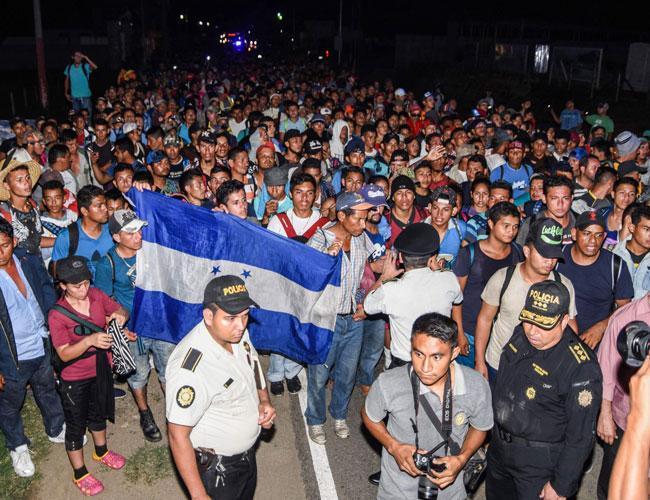
President Donald Trump said on Oct. 22 the United States will start cutting aid to three Central American countries as a caravan of thousands of mostly Honduran migrants rolled on toward the US border.
The United Nations said more than 7,000 people were now heading toward the United States, as more migrants joined the original group, including some Central Americans who were already in Mexico.
Trump meanwhile kept up his almost-daily Twitter attacks on the approaching caravan, calling it a national emergency and saying he had alerted the US border patrol and military.
“We will now begin cutting off, or substantially reducing, the massive foreign aid” that the United States gives Guatemala, Honduras and El Salvador, said the president - who has seized upon the crisis in the run-up to US midterm elections, reviving the immigrant-bashing rhetoric that helped get him elected in 2016.
“Sadly, it looks like Mexico’s Police and Military are unable to stop the Caravan heading to the Southern Border of the United States. Criminals and unknown Middle Easterners are mixed in,” he added.
Mexico’s Interior Minister Alfonso Navarrete vowed his country would not bow to “any government that intends to provoke a hostile reaction in Mexico,” saying leaders there would “continue to call for dialogue.”
Mexican authorities had managed to block the migrants on the Mexico-Guatemala border after they burst through a series of barriers on the Guatemalan side on Oct. 19. But many later crossed the river in makeshift rafts before marching north.
Late Oct. 22 Mexico allowed several hundred Honduran migrants who are part of the caravan into its territory, an immigration official told AFP.
The caravan resumed its journey on Oct. 22 in the state of Chiapas in southern Mexico, setting out from Tapachula, near the border, for the town of Huixtla, around 40 kilometers (25 miles) away.
Many of the migrants had spent the night on the town square or the street, wary of official shelters. They set out on foot or hitched rides with passing cars and trucks, many walking in plastic shoes or flip-flops.
Activists say the journey of at least 3,000 kilometers through Mexico could take a month.
“We’re a little afraid the police could detain us. But if they deport us, we’ll just try again,” Noemi Bobadilla, 39, a cleaner from San Pedro Sula, Honduras, told AFP.
She had already been walking for 13 days.
“We are well aware that this country (Mexico) didn’t receive us as we expected, and they can return us to Honduras, and we also know there are drug traffickers who kidnap and kill migrants,” said Juan Flores, another migrant.
“But we live with more fear in our country, so we carry on.”
Highlighting the dangers the migrants face, one 25-year-old man in the caravan was killed on Oct. 22, apparently when he fell off a vehicle that had let him hitch a ride, said state authorities in Chiapas.
Rights activists accused Mexico of mistreating the migrants.
Several groups accused the Mexican government of “arbitrary detentions” and “grave human rights violations” for detaining migrants who tried to enter the country legally and file asylum claims.
Mexico’s incoming foreign minister, Marcelo Ebrard, promised “substantial changes” on migrant policy after leftist President-elect Andres Manuel Lopez Obrador takes office on December 1. He said Mexico would seek to boost investment in Central America to slow the flow of migrants.
Other activists accused Trump of using the caravan to score political points.
“Trump isn’t afraid of the caravan, Trump is using the caravan to win Congress,” said Irineo Mujica, an activist who helped organize another migrant caravan that also infuriated Trump in April.
US Secretary of State Mike Pompeo, however, denounced the “apparent political motivation of some organizers of the caravan.”
The caravan left San Pedro Sula in northern Honduras more than a week ago.
Many of the migrants are fleeing poverty and insecurity in Honduras, where powerful street gangs rule their turf with brutal violence.
With a homicide rate of 43 per 100,000 citizens, Honduras is one of the most violent countries in the world, according to a Honduran university study.
US aid to the region had already been on the decline.
It went from $750 million in 2016 to $655 million last year, and is on track to fall to $615 million this year, according to the Washington Office on Latin America.
Still, it is vital money for countries such as Honduras, which received $181.7 million last year - a sizeable chunk for a nation whose government budget is less than $10 billion.